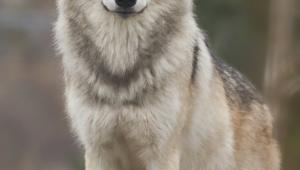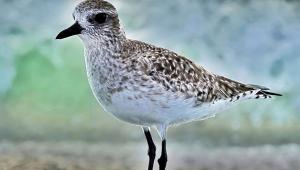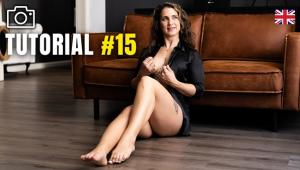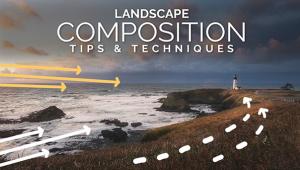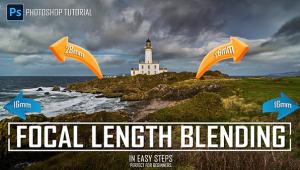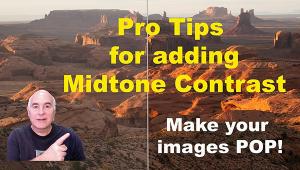Turn Off Your Flash For Digital Images
For this retro portrait of Tia, I placed a Westcott Spiderlite
TD5 with five 23w fluorescent bulbs 3 ft from her on camera right.
A medium (24x32") Westcott Box was attached and the internal
baffle was used to soften the light more and spread even illumination
to the light bank's corners. A 32" Sunlight Westcott
Illuminator reflector was placed on camera left to bounce some,
but not too much, light into the shadow side of the model's
face. While the Canon EOS 20D can shoot directly in Sepia mode,
later on I used PixelGenius' (www.pixelgenius.com)
PhotoKit Photoshop compatible plug-in to add a brown tone to the
finished photograph. Since many of the still images from the movies
in those days were made with a soft focus lens, I added soft focus
to the portrait with B+W's software (www.schneider-kreuznach.com/
filter_e/software_filter.htm) Soft Focus filter. |
The RGB spikes of output from high-color fluorescent light closely match the
receptive RGB spikes of a CCD imaging chip. A CCD is least sensitive in its
blue channel and tungsten light has the least output in the blue, and when combined
with the effect of infrared output (mostly heat) it can overcome the chip's
entire spectral response. What about CMOS? It's difficult to generalize
a head-to-head comparison between CMOS and CCD image sensors, but assuming competent
engineering and optimum settings for white balance, exposure, and light levels,
image quality from CCD sensors should be similar to image quality from CMOS
sensors, at least in terms of color accuracy.
Comparing fluorescent continuous light sources to tungsten lighting is a lot
easier. Fluorescent easily comes out the winner when compared to tungsten, which
is 93 percent heat and 7 percent red light. Techies who want to delve deeper
into light and color should visit Osram's Encyclopedia of Light (www.osram.com/service_corner/glossary/index.html).
What does this mean for digital photographers? It's simple: The light
you used to hate, you can now love. Making all of this easy for us and wrapping
these fluorescent lights in a useful package are a trio of digital lighting
kits from three different manufacturers that can change the way you make portraits.
 |
|
|
Itsy-Bitsy Spider
Westcott's Spiderlite TD5 is designed for still and video image-makers
and works with either halogen or fluorescent lamps. The halogen lamps produce
a consistent but hot 3200Þ Kelvin and the fluorescent lamps are rated
at 5100Þ Kelvin, although that varies as the lights warm up. After using
a color meter to set the exposure, I found my Canon EOS 20D produced better
results in Auto White Balance mode. Your chip may vary...
The all-metal Spiderlite TD5 has a built-in speed ring for attaching a light
bank and three separate switches that let you use multiple combinations of the
lamps. A handle allows quick and easy rotation. The fluorescent lamps provide
smooth, continuous light so that all of my exposures in this session were made
in (gasp!) Program mode. I used the digital SLR's Exposure Compensation
feature to increase exposure in 1/3 stop increments by looking at each image
file's histogram on the camera's preview screen to make sure exposure
was balanced.
 |
|
|
Check Your Ego At The Door
From the mind of Gary Regester comes the Lowel Ego, a tabletop fluorescent soft
light. Setup is a breeze: plug it in, place it on the table or light stand,
and turn it on. The Ego comes with two 27w screw-in compact daylight fluorescent
lamps that have a 5000-10,000 hour rating. Their Color Rendering Index (CRI)
provides a more natural and realistic color balance than standard (color-me-green)
fluorescent lamps. Lowel includes a hinge-folded white bounce card for reflected
fill. It can be used for portraits but is also useful for making tabletop shots
by eBayers, archivists, and desktop publishers. The Ego can also be used for
webcam desktop video conferencing.
When using the Ego light as a main light for portraits, be sure to place the
light as close as possible without getting it in the shot. Because of its small
size, the Ego light is probably best suited to headshots and that's a
good thing. I used to hate setting up lights for headshots; it took too much
time fiddling to get the light looking like I wanted. The Ego sets up quickly
and when used with a reflector, such as Westcott's Illuminator placed
close to the subject on the other side of their face, makes an ideal headshot
setup. I like doing headshots again and never thought that would happen!
 |
|
|
Sunpak Lights
I do a lot of shoots with new and inexperienced models. Big, complex light banks
attached to electronic flash units distract from the mood I try to establish,
so the Sunpak digitLITE 600, which is basically a cold "hot light,"
is a great setup for these kinds of portraits. The light is solidly built and
easy to move around if your light stand has casters, and creates the kind of
working environment that helps the model relax and be at her best. The digitLITE
600 uses cool fluorescent tubes that are balanced for daylight and do a good
job of emulating the real thing.
I use a digitLITE 600 as a main light or as a beauty light placed below the
model's face, in ways I formerly used a reflector back in the old film
days to create the kind of look that requires the least amount of gear possible.
There are photographers, like my wife Mary, who shoot with available light,
but what she really means is "every light we have available." If
we had 20 lights in the studio, she would use them all. The work would be perfectly
gorgeous but I hate to schlep all that stuff. That's why the Sunpak works
so well for my "shoot-and-scoot" style of photography.
 |
|
|
Product Photographs Made Easier
The Sharpics D-Flector is a unique reflective background that activates when
photographed with a flash. The result is a picture with a clean white background
with the object appearing to be floating on air. Used with these fluorescent
lights, the D-Flector is a literal "background in a briefcase" that
is perfect for professional photographers, web designers, or anybody who wants
to document inventory or personal possessions. It's also ideal for making
photographs when selling merchandise on eBay.
 |
|
|
Manufacturers/Distributors
Adorama Camera, Inc.
42 W 18th St.
New York, NY 10011
(800) 223-2500
(212) 741-0052
www.adorama.com
Lowel-Light Manufacturing, Inc.
140 58th St.
Brooklyn, NY 11220
(800) 334-3426
(718) 921-0600
www.lowel.com
Sharpics Inc.
9921 Carmel Mountain Rd. #322
San Diego, CA 92129
(858) 780-0072
www.sharpics.com
ToCAD America Inc. (Sunpak)
300 Webro Rd.
Parsippany, NJ 07054
(973) 428-9800
www.tocad.com
Westcott (The F.J. Westcott Company)
1447 N Summit St.
Toledo, OH 43604
(800) 886-1689
www.fjwestcott.com
- Log in or register to post comments











